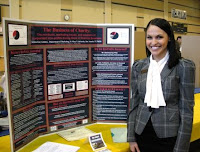
Ever have to settle a friendly wager about which mountain is higher or how big the country really is? There's one handy government web page that can answer these questions and many more of interest to any geography geeks: the USGS'
Elevations and Distances in the U.S. I used this particular resource the other day when I needed to pin down some geography trivia for my personal blog. The question was the elevation of San Antonio, subject of a dispute between me and my husband.
 I found the range of 505-1000 feet above sea level for San Antonio's elevation. (Unfortunately, my husband's guess beat mine.) So what about other Texas cities? The website gives elevations for the 50 largest cities in the country, a list which contains 6 in Texas:
I found the range of 505-1000 feet above sea level for San Antonio's elevation. (Unfortunately, my husband's guess beat mine.) So what about other Texas cities? The website gives elevations for the 50 largest cities in the country, a list which contains 6 in Texas:
- Houston is at the bottom, elevation-wise, with a "variation" of 0 to a whopping 83
- Dallas: 390-686
- Austin: 406-1080 (the biggest variation, which would come as no surprise to Austin-area bike-riders)
- Fort Worth: 513-766
- El Paso: 3695-4080...wow!
El Paso's city elevation has a ways to go to catch up with the state's highest point, though,
Guadalupe Peak, at 8,749 (see left). Texas is far behind the big boys, elevation-wise, though. The

highest point in the U.S. is Mt. McKinley, in Alaska, at 20,320. Mt. Whitney, in California, at 14,494' barely beats out Mt. Elbert in Colorado, 14,433', for the highest point in the lower 48. But we Texans shouldn't feel too inferior—we're head-and-shoulders above Florida's high point of 345!
What about the lowest point? In Texas it's sea level anywhere along the Gulf coast. For the country, the lowest elevation by far is
Death Valley, in California, at 282'
below sea level. The only other state with a below-sea-level mark is Louisiana, namely New Orleans at -8'. That's why hurricanes are such a worry there.

The web page doesn't only deal in highs and lows. An unusual section gives various locations that can claim to be the center of things. Where is the "Heart of Texas," really? According to the USGS, the geographic center of the state is in McCulloch County, 15 miles northeast of Brady (where my parents were married, so my Texas bona fides run pretty deep!).
What about the center of the country? Depends on whether you're looking at the lower 48 or the whole 50. Answers are Lebanon, Kansas, and Castle Rock, South Dakota.
And we're talking about a pretty big country, no matter how you measure it. The USGS reckons that from Maine to Hawaii we're 5,859 miles wide. And from the southern tip

of Texas due north to the Canadian border is 1,602. Our southern boundary runs for 1,933 miles, and the northern (lower 48 only) for 3,987. From sea to shining sea, indeed!
All kinds of other fun facts are lurking on the web page. And it's available gratis from your government. So you don't even owe anyone a cut next time you use it to win that bet or ace that trivia contest!





































